How long to store carrots: the best storage methods
With the onset of autumn, any summer resident begins to wonder how to preserve the harvest grown with love. Of course, carrots are no exception, because this vegetable is quite capable of lying all winter.
Next, you will learn how and where you can create ideal conditions for storing carrots for a long time until spring.
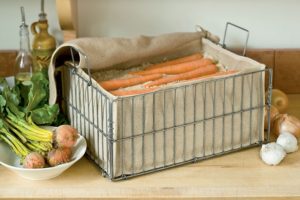
Content
- 1 When and how to remove carrots from the garden: external signs of cooking for collection, terms and rules for digging for storage
- 2 How to properly keep fresh carrots: basic rules and conditions for long-term storage
- 3 Popular ways to keep carrots fresh
- 4 Other ways to store carrots: dried and frozen
When and how to remove carrots from the garden: external signs of cooking for collection, terms and rules for digging for storage
So, September comes, when it's time to start looking at the carrots, namely, the color of its lower leaves: they should turn yellow. This is the main signal for harvesting. However, in addition to the fact that you need to choose the right moment (time) for harvesting, you still need to dig it up and prepare it for storage.
Note! The site already has an article about when and how to dig carrots from the garden and properly prepare for long storage.
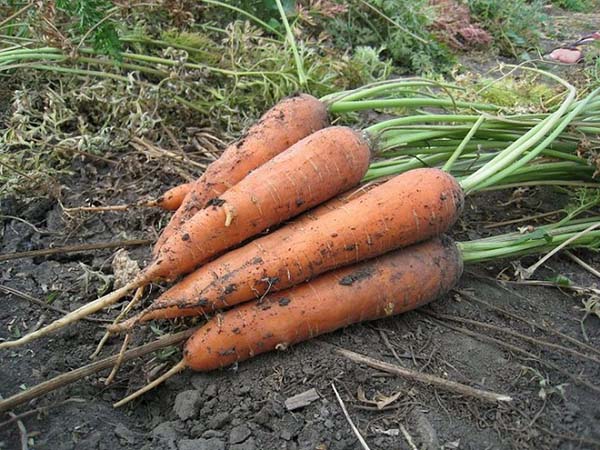
Worth knowing! The accumulation of nutrients and vitamins occurs in the last stage of carrot growth (at low above-zero temperatures, up to + 4..6 degrees), so you should not harvest earlier than it ripens.
Some summer residents even believe that carrots must be removed from the garden immediately after frost, a beets - before their occurrence.
However, as experience shows, this is nothing more than a myth: frozen carrots will not be stored!
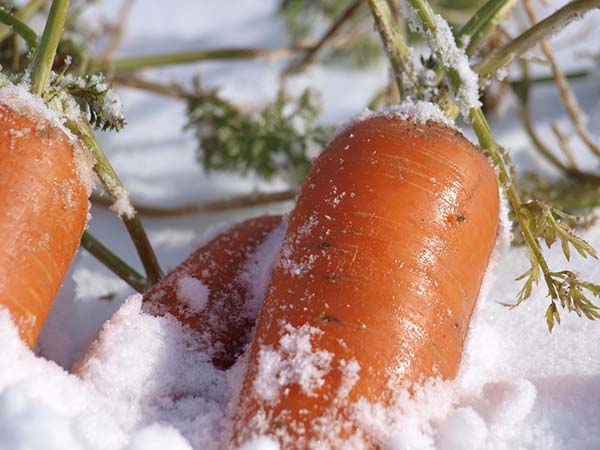
Preparing carrots for storage
- Optional Rinse or at least clear the earth.
To wash or not to wash? Over time, most gardeners come to the conclusion that it is better to wash.
After all, it is quite obvious that during the washing process it is possible to better examine the damaged roots in order to subsequently reject them.
In addition, washed carrots will be stored in the same way as unwashed ones. The main thing is that there are no spoiled places.
- To prevent carrots from sprouting, before storing them, you must cut off all growth points from the side of the tops (ie cut off the "butt" by 0.5 cm).
- Required dry thoroughly (not in the sun, but preferably in the shade, so as not to curl).
- Conduct selection root crops subject to long-term storage.
Naturally, the best specimens should be selected for storage. Small ones (dry quickly), cracked (an infection will get through the cracks, and they will quickly disappear), as well as with a green tail (bitterness will spread throughout the root crop) - will not be suitable for storage.

Note! The site already has an article about when and how to dig carrots from the garden and properly prepare for long storage.
Video: storing carrots - the most important points for preparing and preserving root crops
Carrot varieties for long storage
Obviously, not all carrot varieties are suitable for long storage:
- Early varieties are still more for eating and juicing than storage.
- Whereas mid-season and late varieties are distinguished by the best keeping quality and they are grown for winter storage.
Interesting! It is believed that thick and short carrots are better stored, rather than cylindrical varieties (Nantes, Vitamin, Amsterdam).
How to properly keep fresh carrots: basic rules and conditions for long-term storage
Optimal storage conditions
- the ideal temperature for long-term storage is 0 .. + 2 degrees;
If you have warmer conditions in the basement / cellar (above +4 and up to +10), then so that the carrots do not germinate, before storing them for storage, they must cut off all growth points from the side of the tops (ie cut off the "butt" by 0.5 cm).
- humidity - 80-90%.
The success of storing carrots (like beets) is highly dependent on the moisture in the basement.
- If the basement is very damp, then, for example, in the sand, carrots will be stored poorly and will definitely rot. But keeping in moss is much better, because it allows air to pass through well, and it is itself an antiseptic.
- If, on the contrary, the cellar is very dry, then keep it here, even in the sand, even in the moss: anyway, after a month the carrots will dry out (you will get mummies).
- It is very important to take into account that the temperature and humidity are constant.
Thus, the storage space for carrots should be cool, dark, moderately humid and well ventilated.
Only being in the aforementioned favorable conditions will carrots not rot, wither, dry and germinate.
Where to store it: the best place
Accordingly, the most suitable place to store carrots is basement (underground) or cellarif you live in a private house.
In general, you can store in the garageif it is insulated enough.
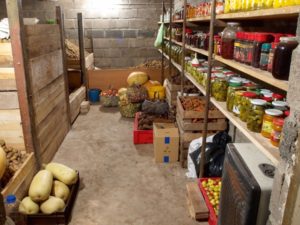
If you only have a summer cottage, then you will have to store at home in a refrigerator, or on an insulated balcony or loggia.

Container and storage method
For long-term storage of carrots, it is very important to choose the appropriate container, and substrate, in which the roots will be stored.
As a container for storing carrots, wooden and plastic boxes, polypropylene sugar bags are ideal.
Next, let's take a look at all of the most common ways to keep carrots fresh during the winter.
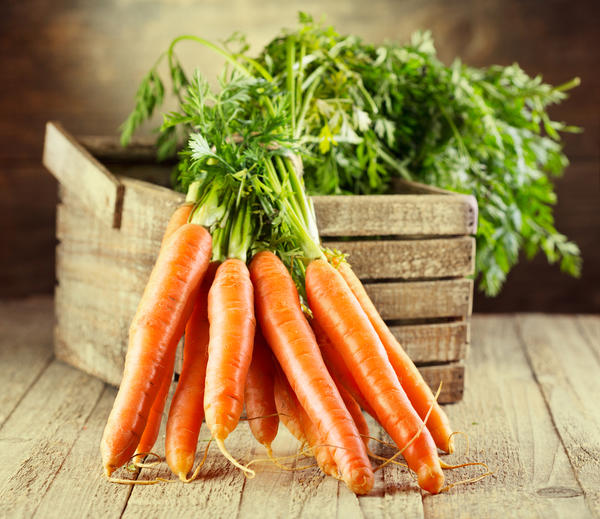
Popular ways to keep carrots fresh
Well, we will list and describe the main methods and technologies for storing fresh carrots at home.
In sawdust
Perhaps the most popular and effective way of storing carrots for a long time is to sprinkle it with sawdust (coniferous - spruce or pine).
Take any container (container), pour a layer of sawdust on the bottom, and then lay the carrots in layers and sprinkle each layer with sawdust.
Sawdust has antiseptic properties that prevent root crops decay, and are also able to retain moisture necessary for long-term storage.
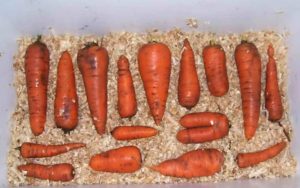
In sand
Storing carrots in sand is no less popular among residents of private houses with cellars or cellars than in sawdust.
After all, sand is another great way to maintain juiciness and prevent mold from growing on roots.
The technology is similar: pour sand on the bottom of the container (container), then lay out the roots in one layer and sprinkle it with sand, then again a layer of vegetables and sand.
The sand should be neither wet nor dry, but slightly damp.
The method of storing carrots in the sand is suitable if your cellar is not dry and not too humid (ideal conditions), otherwise, the roots will either dry out or rot.
As for the sand itself, any clean (no organic impurities) will do.
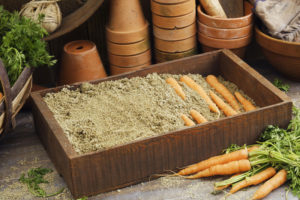
Video: how to store carrots in a cellar in the sand
In moss
No less effective way of storing carrots in moss sphagnum.
Remember! If your basement has a very high humidity, then, for example, carrots in the sand will be poorly stored and will definitely rot. But in moss it is much better, because it allows air to pass through well, and itself is an excellent antiseptic.
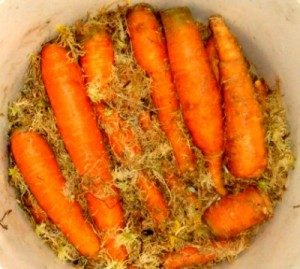
In clay
Of course, a little less popular, but a rather effective method of storing carrots in clay.
Here's what to do:
- Prepare an earthen solution (not thicker than sour cream in consistency).
- Dip each root vegetable in clay so that it covers it completely.
- Dry.
Or, alternatively, you can pour clay on the roots already placed in the container.
- Place in a cellar or basement for storage.
Thanks to the clay shell, the carrots will not dry out and will be inaccessible to various microbes.
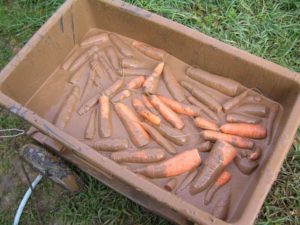
In onion skins
In general, the method of storing carrots in onion peels is similar to using sawdust: the first layer is onion peel, then carrot, then peel again.

In chalk
Alternatively, you can sprinkle or powder the carrots with chalk and then put them in boxes for further storage.
In plastic bags (vacuum and with holes)
Many people find that it is best to store carrots in tight plastic bags (for freezing).
So, the first way to store carrots in vacuum bags: cut off the “butts” (growth points) and ends, wash thoroughly, dry slightly, and then put in bags, tightly tying and releasing air.
In any case, it will be better if, before tying the bags, draw out all excess air from them, for example, vacuum cleaner.
Or you can take a straw for juice or cocktail, insert into a bag of vegetables, squeeze and pull out all the air through the tube, then immediately tying tightly. So much for vacuum packaging!
Video: storing carrots in bags with vacuuming air
The point of storing carrots in an airtight bag is to prevent air from getting inside.Then there will be no decay process or drying (loss of moisture).
In addition, during storage, carrots will release carbon dioxide, which will act as an additional "preservative".
Video: experiment result - how to keep carrots in bags without air
Idea! Similarly, you can wrap carrots in plastic wrap (so you don't even have to pump out the air).
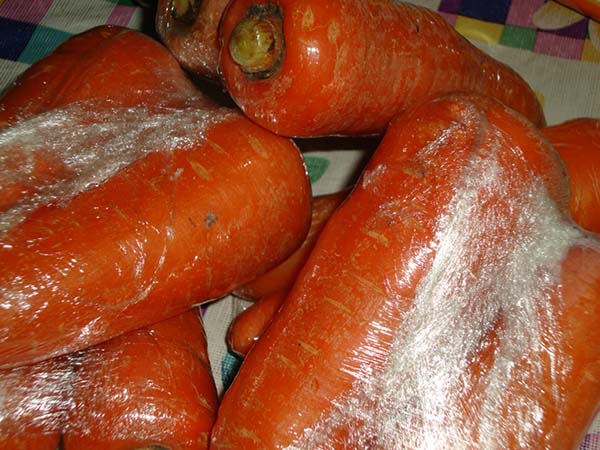
You can also store carrots in plastic bags with ventilation holes.
However, as experience shows, in such non-vacuum packaging, carrots will be stored much worse and will start to rot quickly enough.
In other words, the method is suitable only for short-term storage (1-2 months).

Sugar bags (polypropylene bags)
In general, the process of storing carrots in polypropylene sugar bags is similar to storing carrots in polyethylene bags with holes.
Important! The main thing is not to tie your bags!
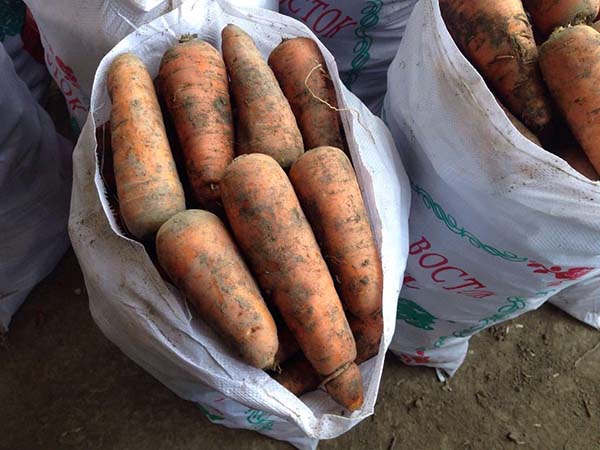
In glass jars
Carrots keep well in jars. Put washed and dried carrots tops on the bottom in clean jars, with the roots up to the neck. We do not close the jar, but turn it upside down and put it on the floor in the cellar. Good, if the cellar is earthen... The carrots will sort of grow in a jar.
With horseradish and potatoes
In boxes (cardboard or wooden), you can also store layered carrots with horseradish.
Why with horseradish? Horseradish roots will act as an antiseptic, preventing decay and mold.
And some also store carrots in potatoes.
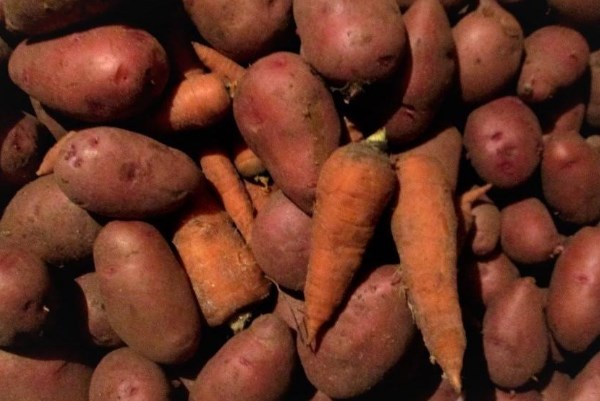
Other ways to store carrots: dried and frozen
Note! Dried, like frozen carrots, retains all the nutrients and can be stored for more than 1 year.
Dried
So, you need to peel and then grate the carrots on a coarse grater. After that, dry it in any convenient way, including in the fresh air. Of course, an electric dryer is best suited for this (as a last resort - an oven, at 50 degrees with an open door).
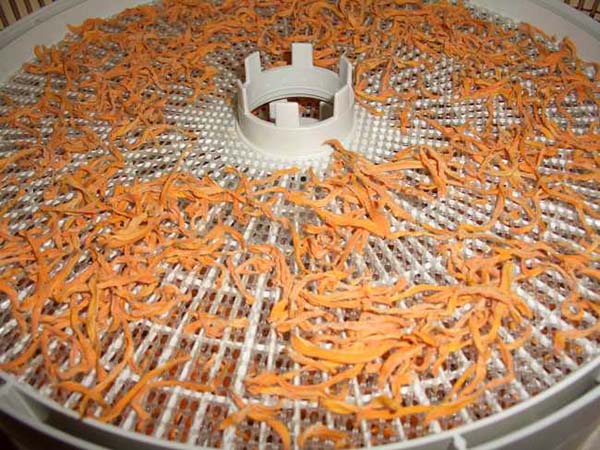
Then fill the glass jar, close the airtight lid and store in the kitchen cabinet.
Store only in a dry place!
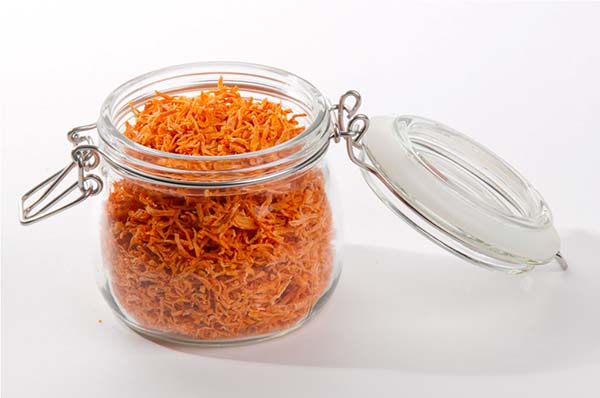
Video: how to dry carrots in an electric dryer
In the freezer
The technology for preparing carrots for freezing is similar: washed, peeled, rubbed on a coarse grater, placed in bags or containers for freezing and put into the freezer.
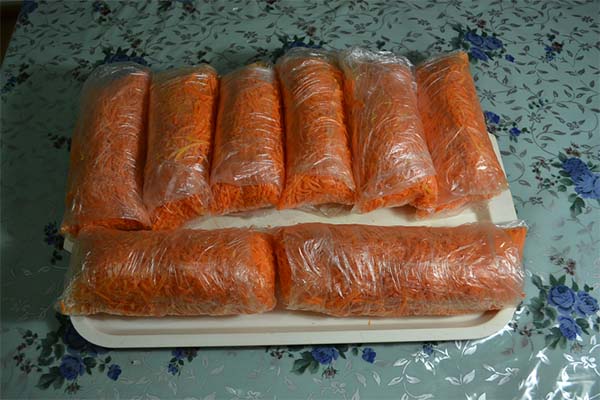
Advice! Before putting the carrots in the freezer, it is advisable to remove all the air from the bags.
Video: how to freeze carrots
Thus, following simple tips and tricks for storing carrots at home, juicy and fresh root vegetables will delight you all winter and even spring.
Video: how to store carrots in winter - the best storage methods

